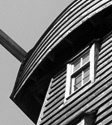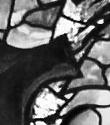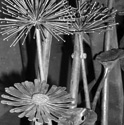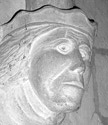 |
 |

Subject: Urban Otters
Journal: The Times Date: December 1999 Author: Clive Fewins
If you are prepared to stand all night overlooking the parapet on the bridge over the River Itchen in the centre
of Winchester on any night of the year and pinch yourself every hour to keep awake you’ll stand a pretty good chance
of seeing an otter. They are there: England’s most urban otters. And males – dog otters – pass that way most nights
in search of bitches and of food. Whether you see them depends not only on luck but also the flow of the river, and
whether or not they decide to take a rest beside the nearby mill, where a concealed camera has photographed the otters
regularly since it was positioned there by scientists from the Environment Agency two years ago.
 With patience you will see one ...
A team from the agency has identified 13 individual otters that frequent the full length of the river, between its
upper reaches near Alresford, and Southampton Water. The otters are believed to be descendents of a tiny residual
population that managed to survive on the river, despite the several urban areas it flows through, during the sixties
and seventies when otters came close to extinction in many parts of England. The ‘otter count’ on the Itchen has been
possible due to a new technique involving DNA profiling rather than photography, which is a notoriously hit and miss
method of recording the identity and movements of the reclusive mammals. The technique, applied to animals in the wild,
is in its infancy in this country. It is a big leap forward on previous techniques used to study otters because it can
identify the otters by sex – obviously valuable information – and other individual characteristics.
“It is important that we should know as much about otters as possible because they are a flagship species,” said Tim
Sykes, the Environment Agency’s project leader for the work. “The more we learn about them the less chance there is
that they will come close to extinction again, as they did in the sixties and seventies when some of the harmful
pesticides in use at that time came close to wiping them out. “Otters are so important to us because they are such
a sensitive species and a barometer of the success or otherwise of humans in managing the natural environment.”
The recovery has been assisted by the work of groups such as the Hampshire Wildlife Trust, members of which have
created artificial holts and habitat improvement schemes in the catchment area of the Itchen for the past 10 years.
The DNA work was a feasibility study to try and find out whether profiling using this technique had the potential to
give a complete picture of the otter population in four selected river catchment areas. “It has been an outstanding
success, but only thanks to more than 50 volunteers who turned out at dawn in all weathers over a twelve month period
to collect fresh otter droppings – known as spraint – on the four test rivers,” Mr Sykes said.
The other key factor has been the work of Dr John Dallas at Aberdeen University, where all the material extracted from
otter spraint was analysed and turned into DNA profiles. The work on the other three rivers – all in the West Country –
was supervised by Dr Paul Chanin of Exeter University, an international authority on otters. Together with his colleague
Karen Coxon he organised the work of volunteers from the Devon wildlife Trust and the Somerset Otter Group on the rivers
Tone, Brue and Torridge. Altogether in the four river catchments the volunteers covered an estimated 1,200km on foot in
all weathers – mainly very early in the morning when the spraints are at their freshest – during the study, which lasted
12 months on the west Country rivers and 20 months on the river Itchen.
“We collected 622 fresh spraints and managed to extract DNA from 119, with a success rate ranging between 16 per cent
and 43 per cent,” Tim Sykes said. “Fifty-seven different otter DNA profiles were identified, 31 males and 26 females.
Part of the success is that it has told us areas in which we need to improve the DNA fingerprinting technique. Until we
manage to refine the technique it is still difficult, for example, to distinguish between two closely related siblings,
such as two brothers.
“However the technique has provided us with vastly more information than radio tracking, which has been used before with
captive bred otters that have later been released to the wild. Radio tracking only tells you about the movements of animals
wearing collars, while DNA profiling tells you much more about how otters live and travel around. Besides, capturing wild
otters in order to attach radio collars is frowned upon, as well as being extremely difficult.
“Through his DNA profile one dog otter was recorded 23 separate times over a period of 19 months on the River Itchen
from which we concluded that his territory covered pretty well the whole 39km of the river. This was a fantastic
demonstration of the effectiveness of DNA profiling. However we still need to perfect the technique so that it might
perhaps give us some idea of the relationship between different otters.
“We should also like to extend the study to more rivers so we can learn more about otter movements between different
river catchment areas. Otters are able to move quite swiftly overland and one thing we do not know at present is whether
some of the otters we tracked were ‘residents’ in their river catchment areas or whether they were just passing through.
“The presence of few or no resident animals might indicate a poor habitat, in which case we might be able to do something
about this. On the other hand if a high proportion of the otters we managed to profile were on the move they could play an
important part in recolonisation by otters in many other parts of the south and south-west of the country, which would be
good news for everyone.”
|
|||||||
| © 2006–2025 Clive Fewins. All rights reserved. | Site designed by Ridgedale Communications Ltd. | |||||||||||||||||||||






